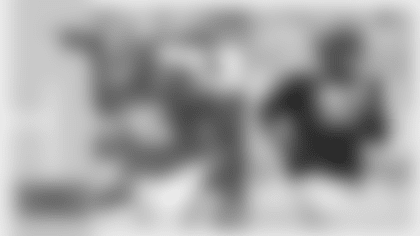Having had a two-game winning streak abruptly ended in an improbable overtime struggle, the Green Bay Packers (3-3) take to the road in search of a fourth victory, invading St. Louis Sunday to meet the Rams (3-2).
Kickoff for the contest, at the Edward Jones Dome (66,000), is set for 12 noon, CDT (Wisconsin time).
To a stunned, capacity house of 70,407 witnesses, the weekend's ultimate result was "improbable" because the Packers had appeared to be comfortably out front of the undefeated Kansas City Chiefs at the end of three periods (31-14). But the surprisingly resilient Missourians suddenly accumulated 20 fourth quarter points, forcing the game into overtime, then won it in sudden death, 40-34, by way of a 51-yard pass to wide receiver Eddie Kennison at 6:18 of the overtime. The Chiefs thereby dealt the Packers only their second Lambeau Field loss in the last two seasons.
The defeat, the Packers' first overtime loss since 1995, dropped the Green and Gold 2-1/2 games behind the NFC North Division leading Minnesota Vikings (5-0), who were idle over the weekend.
In St. Louis, where the Packers last visited in January of 2002 for a Divisional Playoff game, the Packers will be seeking a third straight regular-season victory over the Rams.
THE TV-RADIO COVERAGE: Dan Miller will handle the play-by-play and Brian Baldinger will provide the analysis for the Fox Sports Network's telecast of Sunday's game. Pete Macheska produces and Mike Frank is the director.
The game also will be aired over the 62-station Packers Radio Network, with Wayne Larrivee calling the play-by-play and Larry McCarren providing analysis and commentary. The radio broadcast also will be available on www.packers.com for NFL Field Pass subscribers.
Additionally, the game will be broadcast nationally by Westwood One, with Dave Sims delivering the play-by-play and Jack Ham offering the analysis.
THE SERIES: The Packers and Rams will be meeting for the 85th time in a venerable series which has seen the impending hosts hold forth in four different locales over their 66-year history.
The Rams, launching their existence in Cleveland in 1937, moved to Los Angeles in 1946, to neighboring Anaheim, Calif., in 1980, and most recently, to St. Louis in 1995.
The Packers own a 2-1 advantage over the "St. Louis" Rams in regular-season competition but have unhappy memories of their most recent encounter, one which saw the Missourians make off with a 45-17 victory in an NFC Divisional Playoff at St. Louis following the 2001 season.
All three of the Green and Gold's regular-season meetings with the St. Louis Rams have had a special significance from the Packers' perspective:
-In 1995, the Rams' first appearance in Green Bay under the St. Louis banner, they shaded the Packers, 17-14, thereby dealing them their only Lambeau Field loss of the season.
-In 1996, the Packers - coming off successive losses to the Kansas City Chiefs and Dallas Cowboys - invaded St. Louis and scored a key, "turnaround" victory over the Rams, 24-9, launching a five-game, season-ending winning streak en route to a second consecutive NFC Central Division championship and, ultimately, a 35-21 triumph over New England in Super Bowl XXXI.
-And, in 1997, the Packers' 17-7 win over the Rams (Nov. 9) enabled them to establish a new club record for home field success with a 21st consecutive victory in Lambeau Field, surpassing the previous team record, 20 straight, set by the 1929-32 Packers under team founder Earl "Curly" Lambeau.
Although the Packers have been closing the gap over the past decade, having won 6 of their last 8 regular-season matchups, the Rams still lead the series, 43 victories to Green Bay's 39. There also have been 2 ties.
Sunday's principals have split their two postseason meetings. The Packers registered a 28-7 victory over the Rams in their 1967 Western Conference playoff at Milwaukee County Stadium to qualify for what became the storied "Ice Bowl" in the NFL Championship Game against the Dallas Cowboys eight days later but the Rams prevailed in their '01 NFC Divisional Playoff.
THE COACHES: Highly consistent, meticulously prepared and invariably positive, Mike Sherman presided over more victories (33) in his first three seasons than any other head coach in the Packers' 84-year history...more than team founder Curly Lambeau (14), more than Vince Lombardi (26) and more than Mike Holmgren (27) over that productive span.
While so doing, Sherman also has entrenched himself in what has become a greatly expanded role (he attached the titles of executive vice president and general manager to his résumé after just one year as head coach), leading Green Bay to three consecutive winning seasons and, in 2002, to its first division championship since 1997 en route to a second straight playoff berth, earning Sherman Staples 'Coach of the Year' honors for the '02 season.
Taking on the additional duties with typically total commitment, and literally without missing a beat, he maneuvered the Packers to back-to-back 12-4 records in 2001 and 2002, the Green and Gold thus becoming the winningest team in the NFL over that two-year span (24-8). The 12-4 marks have been exceeded by only four teams in the club's 82-year NFL existence and the 12-12 parlay was only the second such coupling (12 or more victories in successive years) in team annals. His current regular-season coaching mark is 36-18.
En route, the 48-year-old Northborough, Mass., native, who has rivaled the accomplishments of the storied Lombardi over a comparable span, compiling a 33-15-0 mark in his first three seasons (16-game campaigns) compared to Lombardi's 26-12-0 over a similar stretch (two 12-game seasons and one 14-game campaign) while he served as the Packers' head coach and general manager (1959-61).
Sherman also equaled another Lombardi achievement by leading the Packers into the playoffs in only his second season (2001) at the controls.
Along the way, Sherman also has made Lambeau Field an uncomfortable place for NFL rivals to visit. Since he took up residence at 1265 Lombardi Avenue in 2000, the Green and Gold have forged an imposing 23-5 record in "Lambeau" under his leadership - the best regular season record in the NFL during that span, including the NFL's only perfect home record (8-0) in 2002.
The first man in a half-century to take on his tri-cornered roles - since Lambeau functioned as vice president, general manager and head coach in 1949 - Sherman brings multiple credentials to his responsibilities. They include a Super Bowl following the 1997 season, during which he was a member of the Holmgren coaching staff that led the Packers into Super bowl XXXII against the Denver Broncos at San Diego.
It was to be the first of three consecutive years in the playoffs for Sherman, who returned to the postseason with the Packers in 1998 and as the offensive coordinator on Holmgren's staff at Seattle in 1999.
Now in his 26th year in the coaching profession, the tireless Central Connecticut State University alumnus launched his coaching career at Stamford, Conn., High School in 1978. He went on to coach in the college ranks for 16 years, including one year as offensive coordinator at Holy Cross and terms as offensive line coach at such highly regarded programs a UCLA and Texas A&M.
Mike Martz, the 21st head coach in Rams annals, is the mastermind behind one of the most explosive offenses in NFL history, the Rams being the only franchise in league history to score at least 500 points in three different seasons (526 in 1999, 540 in 2000 and 503 in 2001).
Since Martz rejoined the Rams as offensive coordinator in 1999, the Rams have scored more points (1,885), gained more total yards (25,736) and accumulated more passing yards (18,402) than any club during a four-year span in NFL history.
The Rams also produced three most valuable players (quarterback Kurt Warner in 1999 and 2001, and running back Marshall Faulk in 2000).
Martz rejoined the Rams in 1999 after two seasons as quarterbacks coach of the Washington Redskins. He began his NFL coaching career with the Rams in 1992 as offensive assistant, coaching the quarterbacks and receivers through the 1996 season.
A native of Sioux Falls, S.D., Martz launched his coaching career at Bullard High in Fresno, Calif., before moving to the college ranks as an assistant at San Diego Mesa Community College (1974, 1976-77), San Jose State (1975) and Santa Ana College (1978) before returning to his alma mater, Fresno State, in 1979. He served as assistant at Pacific (1980-81) and Minnesota (1982) before moving to Arizona State, where he coached quarterbacks and receivers from 1983-87, and was offensive coordinator in 1984 and from 1987-1991.
As a collegian, he played tight end at Fresno State (1972) after transferring from the University of California-Santa Barbara, which dropped football a season earlier.
THE LAST TIME: The last time they encountered the Rams in the regular season, the Packers found the St. Louisans' modest 2-7 record somewhat deceptive. Required to be content with a narrow 3-0 lead at halftime, they made a few "adjustments" during the intermission and subsequently were able to put a pair of touchdowns on the board in the second half and depart the Mound City with a 17-7 victory.
The game was a scoreless deadlock until only 4:02 remained in the second quarter, when Packers rookie placekicker Ryan Longwell ended the drought with a 44-yard field goal, finishing off a 5-play, 51-yard drive.
After the coaching staff worked its halftime magic, the Packers came out and, in effect, settled the issue, driving 80 yards in 7 plays following the kickoff to score their first touchdown. After a drive-opening pass, intended for wideout Robert Brooks, fell incomplete, quarterback Brett Favre completed the next four in a row - including a 25-yarder to fullback William Henderson and an 18-yarder to tight end Mark Chmura, a parlay which carried the Green and Gold all the way to the Rams' 26-yard line.
Levens had to settle for a yard at right end but, on the next play, Favre's bullseye found Antonio Freeman in the end zone for the score, with only 3:34 elapsed in the third quarter. Longwell's conversion gave the Packers a 10-7 lead and, as subsequent events unfolded, it was all the points they were to need.
The Rams, however, were not inclined to concede at that juncture. With Mark Rypien holding forth at quarterback when starter Tony Banks was sidelined with a back strain, they moved 75 yards in 14 plays to score following the ensuing kickoff, running back Lawrence Phillips finishing off the drive with an 8-yard run again off the right side of the St. Louis line.
To their credit, the Packers then promptly responded in kind, sweeping 79 yards in 9 plays for their second and final touchdown of the day. Favre, who completed a 45-yard bomb to Freeman en route, scored this one himself. With third-and-goal at the St. Louis 7-yard line, he was unable to find a receiver open and, taking matters into his own hands, scrambled into the end zone for the score, cutting back against the grain to reach the end zone.
An exchange later, the Rams found themselves with a glittering opportunity to close the gap, by way of a 62-yard pass-run maneuver worked by Rypien and running back Amp Lee, an effort which took the Missourians to the Green Bay 31-yard line. The Packers defense rose up, however, forcing the Rams to be content with a 36-yard field goal attempt, one which saw Jeff Wilkins' 36-yard effort veer wide left.
Offensively, the Packers' 387-yard production was their third-best of the season, ranking behind only their season-high 396 yards against the Detroit Lions Sept. 28 and their 392 yards against Miami Sept. 14.
The Green Bay defense, with coordinator Fritz Shurmur shrewdly blending a variety of "looks," limited the Rams to an average of 2.6 yards per rush (66 yards in 25 attempts) and sacked St. Louis quarterbacks 4 times for 32 yards in losses - Eugene Robinson, LeRoy Butler, Santana Dotson and a "combo," Seth Joyner and Keith McKenzie, doing the honors.
THE INJURY REPORT: The Packers' defense lost two starters during the course of the game, end Joe Johnson with a quadriceps problem and left cornerback Mike McKenzie with a back problem at halftime. Running back Tony Fisher left the game with a groin injury. It was learned Tuesday that Johnson's injury is a torn right quadriceps tendon that will require season-ending surgery.
THE (NFL) STATISTICAL UPDATE: Mounting 190 yards in a losing effort while continuing to set a brisk statistical pace, running back Ahman Green leads the National Football League in total yards from scrimmage (866), non-kicker scoring (54) and the production of first downs (51) six weeks into the season.
Green also leads the National Football Conference in rushing with 699 yards, an average of 5.3 yards per attempt and is tied for the league lead for most 100-yard rushing games with 4, sharing the latter honor with Carolina's Stephen Davis and the Baltimore Ravens' Jamal Lewis. He additionally ranks among the NFC leaders in third-and-one rushing with a perfect 5-for-5 conversion record.
Quarterback Brett Favre, fourth a week ago, now ranks third among NFC passers with an 86.7 rating, based upon a conference-leading 128 completions in 192 attempts for 1,261 yards and 11 touchdowns, with 8 interceptions.
Favre also ranks sixth in NFC third-down passing with a 77.6 rating, based upon 29 completions in 48 attempts for 290 yards and 5 touchdowns, with 4 interceptions, and eighth in fourth-quarter passing with a 74.4 rating, on 32 completions in 52 attempts ford 323 yards and 3 TD, with 3 interceptions.
Teammate Antonio Chatman remains among the NFC's leaders in both kickoff and punt returns, ranking fifth in KOR with a 23.7-yard average for 24 runbacks and sixth in punt returns with a 9.3-yard average for 11 returns.
On the defensive side of the football, rookie linebacker Nick Barnett and fellow linebacker Na'il Diggs is in a tie for seventh place among NFC interceptors with two "picks."
As a team, the Packers have moved up from 12th last week to 8th on offense (fifth in rushing and 17th in passing) and are now 27th on defense (19th against the run and 30th against the pass).
The Packers lead the NFL as a whole in team offense inside the 20 with an 81.0 touchdown percentage, based upon having scored 17 TDs in 21 possessions. They also rank fourth in the NFC in inside-the-20 defense with a 47.4 TD percentage, based upon having held opponents to 9 TDs in 19 possessions.














